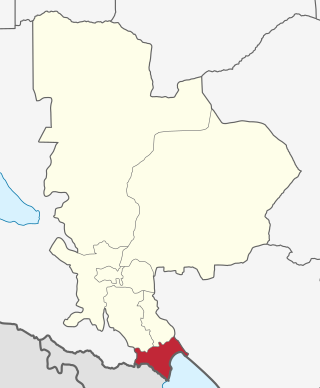
Ludewa District is one of six districts in the Njombe Region in Tanzania, East Africa. Prior to 2012, the district was one of the seven districts of Iringa Region. The town of Ludewa is the administrative seat of the district. A hospital is located in the city. The district is bordered to the north by the Njombe Rural District and Makete District, to the southeast by the Ruvuma Region and to the southwest by the country of Malawi across Lake Nyasa.

Mbarali District is one of the seven districts of Mbeya Region, Tanzania. It is bordered to the north by Iringa region and east by Njombe region. To the south the district is bordered by Mbeya Rural District and to the west by Chunya District.

Kyela is one of the seven districts of Mbeya Region, Tanzania. It is bordered to the north by Rungwe District, to the northeast by Njombe Region, to the southeast by Lake Nyasa, to the south by Malawi and to the west by Ileje District.
Olbalbal is an administrative ward in the Ngorongoro District of the Arusha Region of Tanzania. The ward is home to the famous Olduvai Gorge. The ward covers an area of 7.893 square kilometres (3.048 sq mi) with an average elevation of 1,405 metres (4,610 ft).
Kipawa is an administrative ward in the Ilala District of the Dar es Salaam Region of Tanzania. In 2016 the Tanzania National Bureau of Statistics report there were 92,891 people in the ward, from 74,180 in 2012.
Hazina is an administrative ward in the Dodoma Urban district of the Dodoma Region of Tanzania. The ward covers an area of 8.584 square kilometres (3.314 sq mi).
Idamba is a town and ward in Njombe district in the Iringa Region of the Tanzanian Southern Highlands. In 2016 the Tanzania National Bureau of Statistics report there were 3,250 people in the ward, from 3,148 in 2012.
Igongolo is a town and ward in Njombe district in the Iringa Region of the Tanzanian Southern Highlands. In 2016 the Tanzania National Bureau of Statistics report there were 8,720 people in the ward, from 8,447 in 2012.
Igosi is a town and ward in Wanging'ombe district in the NJOMBE of the Tanzanian Southern Highlands. In 2016 the Tanzania National Bureau of Statistics report there were 7,437 people in the ward, from 7,204 in 2012.
Ikondo is a town and ward in Njombe district in the Njombe Region of the Tanzanian Southern Highlands. In 2016 the Tanzania National Bureau of Statistics report there were 7,163 people in the ward, from 6,312 in 2012.
Ikuna (Ikuka) is a town and ward in Njombe Rural District in the Njombe Region of the Tanzanian Southern Highlands. In 2016 the Tanzania National Bureau of Statistics report there were 9,474 people in the ward, from 9,178 in 2012.
Iwungilo is a town and ward in Njombe Urban District in the Njombe Region of the Tanzanian Southern Highlands. In 2016 the Tanzania National Bureau of Statistics report there were 8,691 people in the ward, from 8,419 in 2012.
Kifanya is a town and ward in Njombe Urban District in the Njombe Region of the Tanzanian Southern Highlands.
Luduga is a village and ward in Wanging'ombe District in the Njombe Region of the Tanzanian Southern Highlands.
Lupembe is a town and ward in Njombe Rural District in the Njombe Region of the Tanzanian Southern Highlands.

Luponde is a town and ward in Njombe Urban District in the Njombe Region of the Tanzanian Southern Highlands. The biggest employer is the Luponde tea factory.
Mahongole is a town and ward in Njombe district in the Iringa Region of the Tanzanian Southern Highlands. In 2016 the Tanzania National Bureau of Statistics report there were 9,520 people in the ward, from 9,222 in 2012.
Usuka is a town and ward in Njombe District in the Iringa Region of the Tanzanian Southern Highlands. In 2016 the Tanzania National Bureau of Statistics report there were 6,344 people in the ward, from 6,146 in 2012.

Uwemba is a town and ward in Njombe District in the Iringa Region of the Tanzanian Southern Highlands. Uwemba has a big Benedictines monastery and Secondary school. Economic activities includes agriculture and business.
Buhanda is an administrative ward in Kigoma-Ujiji District of Kigoma Region in Tanzania. The ward covers an area of 5.5 km2 (2.1 sq mi), and has an average elevation of 864 m (2,835 ft). In 2016 the Tanzania National Bureau of Statistics report there were 8,397 people in the ward, from 7,629 in 2012.





